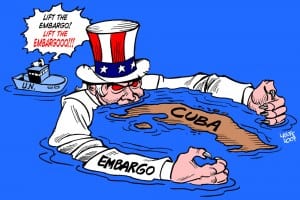The publication of Arnold August’s book “Cuba and Its Neighbours: Democracy in Motion” is an event. The author establishes that democracy is alive in Cuba. He views Cuban democracy as a process moving ahead, but with course corrections. Democracy, he suggests, is really democratization. The process has relied upon political participation by all citizens, progress toward unity and consensus, and exclusion of those bent on accumulation.
August took on a big job. Not only does he detail workings of Cuba’s national parliament and municipal assemblies and explain how elections work – a signal contribution – but he also traces the origins and evolution of democratic stirrings from colonial and slavery times to the present. He summarizes varying approaches to building socialist democracies in Ecuador, Bolivia, and Venezuela, plus points out limitations of U.S. – style democracy. With its rush of themes playing out both simultaneously and over many years, August’s narrative is slow-moving at times, yet remains coherent, factual, and non-polemic in tone. He made effective use of interviews with Cuban activists and analysts.
Discussions in the United States about democracy in Cuba often stumble on the absence of elections following the victory of the revolution in 1959. August explains that revolutionary leaders concurred with most Cubans then that corrupt multi-party elections of the past had no place in the new Cuba. Democratization materialized as the Federation of Cuban Women, Committees for the Defense of the Revolution, and the 1961 literacy campaign. A new Constitution in 1976 instituted elections for municipal assemblies, provincial assemblies, and the National Assembly.
Soviet Bloc parliamentary and electioneering precedents were rejected. Constitutional reforms in 1992 barred the Communist Party from designating members of nomination commissions and provided for popular election of deputies to the National Assembly.
August’s book tells of nationwide community meetings attended by almost all adults where national problems were discussed and action possibilities debated. Recommendations from these episodic meetings often ended up as government decrees and legislation. Such meetings took place prior to the referendum approving the 1976  Constitution and again while constitutional changes were being considered in 1991. In 1994, they centered on the economic crash following the fall of the Soviet Bloc; in 2007-08, on social security, low food production, and low wages; and in 2010, on the Communist Party’s new “Guidelines” for bringing about changes in the economy.
Constitution and again while constitutional changes were being considered in 1991. In 1994, they centered on the economic crash following the fall of the Soviet Bloc; in 2007-08, on social security, low food production, and low wages; and in 2010, on the Communist Party’s new “Guidelines” for bringing about changes in the economy.
August sees participatory democracy playing out in municipal assemblies, which are tools for achieving decentralization, a prime goal of ongoing transformations. He indicates some local assemblies are unable to respond to local needs. Specialists and local delegates are involved in attempts to overcome these weaknesses. Entities known as “People’s Councils” are governing in sub-municipal districts.
Arnold August highlights obstacles for democratization, chief among them corruption and bureaucracy. And tension remains between discontent and consensus, between traditions of centralized authority and notions of popular sovereignty, the latter ironically enough having been endorsed by the government. Uncertainties, suffering, and scarcities at the hands of U.S. economic blockade receive scant attention, yet few would argue they are good for democracy.
The book gets high marks for covering the democracy movement’s deep historical roots. Independence wars in the 19th century fought by poor, racially-oppressed rebels took on social justice, particularly equal rights for black people and equitable land distribution. The 1976 Constitution incorporated words and concepts from constitutions of that era and from ideas of José Martí, Cuba’s national hero. The author honors the mentoring and ideological legacies of Martí, who fell as a martyr in the liberation struggle.
Cuba’s alliance with the former Soviet Union and the Communist Party’s role in propelling political change are hardly reassuring to northern neighbors susceptible to red- scare. For Arnold August, Cuba’s Communist Party is a special case. Martí’s Cuban Revolutionary Party served as its model, that of a single national party. And in 1965, the present Communist Party was brand-new, formed of two non-communist revolutionary organizations and the old Communist Party. The Party runs no candidates in elections and operates in a spirit of innovation.
August wanted “to provide readers with some tools for following the future situation [in Cuba] independently, without the blinders of preconceived notions.” He achieved that. His main point, that Cuban democracy is a moving force and seems to be gaining strength, is convincing. It may be unique on that account, and also for priority given to participation, unity, and consensus as tools for building socialism. If true, that may help explain why Cuban socialism survived the disappearance of the Soviet Union and how Cuba has withstood siege from the neighboring superpower.
Imbued with an understanding of democratic realities in Cuba that this book surely provides, readers in the United States and elsewhere – especially those who are progressive but silent on Cuba – may now see fit to speak out and act in solidarity with a people victimized for 50 years by every stratagem short of open war.
W.T. Whitney Jr. is a retired pediatrician and political journalist living in Maine.



